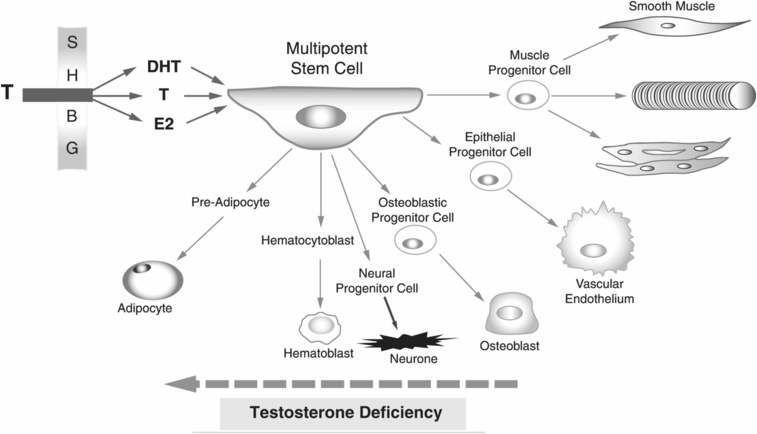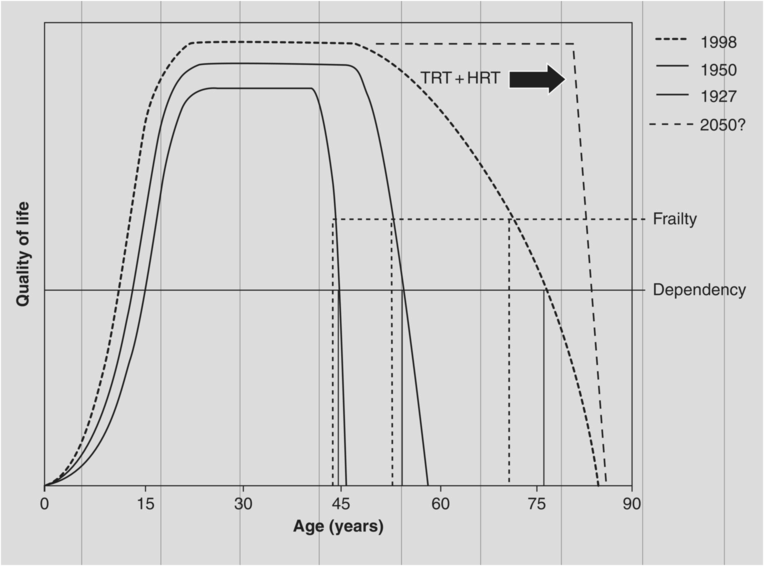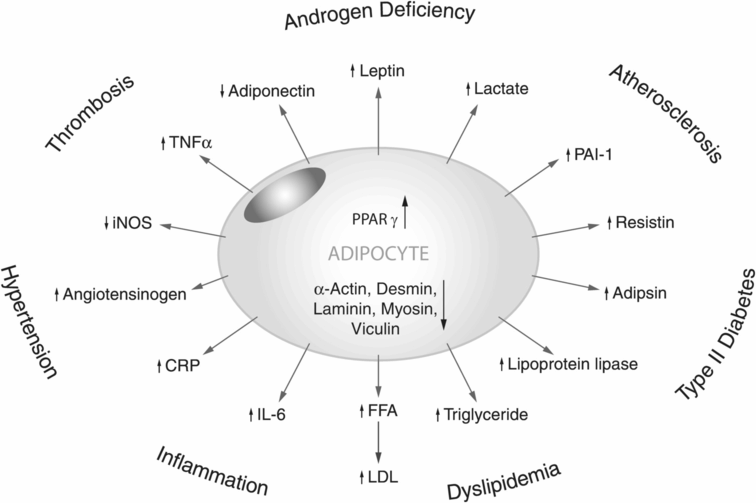Levels of androgen resistance.
Consequences of androgen deficiency
Partly modulated by one of the factors in testosterone deficiency, SHBG, testosterone, dihydrotestosterone and estrogen all act on multipotent stem cells, and modify their differentiation into the progenitor cells forming and renewing the three types of muscle cell, vascular endothelium, osteoblasts, neurons and hematoblast. The consequences of testosterone deficiency can be seen in Figure 27.2.

Effects of androgen deficiency on multipotent stem cells.
This explains why testosterone deficiency can contribute to atrophy of smooth muscle, skeletal muscle and cardiac failure. Further, there is vascular damage and promotion of atherosclerosis due to lack of epithelial cells to repair the vascular endothelium. There may also be anemia due to underactivity of the hematoblasts, together with polycythemia, while a rise in hemoglobin is a regular feature of TRT.
There is evidence that reductions of neural progenitor cells occur, and the resulting decrease in neurogenesis may contribute to Alzheimer’s disease, Parkinsonism and the “brain fog” often seen in testosterone-deficient patients, which clears when they go on TRT.
At the same time, with testosterone deficiency there is a tendency to favor adipocyte production and activity, at the expense of other cells in the body, which has widespread effects that make it the “axis of evil,” by the mechanisms seen in Figure 27.3. This sets the scene for the onset of the “metabolic syndrome” with abdominal obesity, diabetes, hyperlipidemia and hypertension.
More reasons for the opposition to TRT
Despite all the above scientific evidence speaking loudly of the benefits for TRT, there are still many in the medical profession who say that is a rare condition which can safely be ignored.
Sometimes even the most macho of males can suffer from it. Logically, there should be no shame attached, but emotionally there often is. Fortunately there are an increasing number who are willing to stand up and be counted, and they greatly help recognition of the condition and its treatment by doing so.
Also, detractors of TRT point out that the number of testosterone estimations being ordered by physicians prescribing it is not rising at the same rate as its usage. But if you go by diagnosis on history, signs and symptoms, together with monitoring of symptomatic response, then the situation is similar to that in prescription of HRT based on history, symptom and the clinician’s opinion, not on laboratory measures of estrogens.
Why has testosterone had such a bad press?
Firstly, there is the public perception of testosterone as the hormone responsible for undesirable male traits such as aggression and hypersexuality. My experience is that in practice there is no evidence that treatment with this hormone will “bring out the beast” in men, and turn them into rapacious monsters as portrayed in the film “Wolf,” by Jack Nicholson, but this fear holds many menopausal men back from being treated, who unlike him cannot claim to have “retained my testosterone longer than most males.”
Also, reports of the abuse of anabolic steroids by athletes and bodybuilders, together with deliberately exaggerated horror stories of their physical and psychological dangers, have appeared in the newspapers at increasingly frequent intervals over the last 30 years. As testosterone is the basic compound from which all the other anabolic steroids are derived, it is the most important part of this “pharmacological arms race,” as well as being the hormone used to treat the male menopause, and therefore by association it has suffered a very bad press.
In the USA, partly because a prominent Senator’s son overdosed on anabolic steroids, and because national athletics heroes such as Ben Johnson have been disgraced by taking them, there seems to be a “witch-hunt” going on which has turned the minds of politicians, drug companies, doctors and even the Food and Drug Administration (FDA) against testosterone [3].
Especially in the USA, doctors do what they are taught to do, paid to do and not likely to be sued for doing. At present, testosterone treatment doesn’t fall under any of these headings. This has limited the range of testosterone preparations available and made them much more difficult for American doctors to prescribe because they are regarded as dangerous drugs. This means a lot more paperwork has to be filled in if you need to keep stocks and prescribe them, and you are more likely to be sued for mega-bucks if any possible side effects are experienced by the patients. Ambulance-chasing lawyers are advertising for patients who think they may have had any of a range of conditions following even the briefest course of testosterone treatment, inviting them to sue their doctors.
To make things worse, by some inverted logic, the drug regulatory body in the USA, the FDA, allows the most poisonous of the many preparations which can be taken by mouth, methyl testosterone, to be prescribed. This is in the mistaken belief that even athletes, let alone doctors, know that it is toxic to the liver and heart, and therefore won’t obtain it illegally and abuse it. Of course, a few athletes and bodybuilders will be naive enough to use it anyway. The majority are more knowledgeable about it than most doctors, and read the detailed manuals which are put out largely by mail order on this subject. They then get supplies of safer preparations from other countries, especially Mexico, that caters on a large scale for this illicit market.
A report as recently as 2014 found that in Canada methyl testosterone was still the most commonly prescribed form of TRT [4], even though it has been taken off the market in most European countries and Australia.
When HRT was combined with an androgen, it was often methyl testosterone.
The alleged harms of HRT are extrapolated to include TRT by a curious group of nay-saying epidemiologists and endocrinologists who play on the inherent caution of the medical establishment to prevent the spread of hormonal replacement treatments for either sex. They do this by deriding any attempt to hold back the ravages of time as being “the quest for eternal youth,” and preach that people should modify their lifestyle, and learn to “grow old gracefully,” however incapacitating, painful, undignified and expensive to the individual and community that process may be.
Also, they base their beliefs not on the clinical experience of doctors who have expertly applied these treatments to large numbers of patients over many years, but on the application of sophisticated statistics to massive rag-bags of facts and theories gained from huge trials which assume all forms of HRT or TRT have similar endocrine effects in all subjects and can therefore be bracketed together, while largely ignoring any beneficial effects.
They also ignore the fact that very large trials generate differences between groups which may be statistically significant, but can easily be clinically insignificant. Also, it has been said that “If you torture the data long enough, it will confess to anything.”
Finally, they delight in drawing conclusions from their studies which generate “myths” which they can tell to other doctors with no experience of hormone replacement to put them off prescribing the treatment.
The myths of TRT
As President John Kennedy said, “The great enemy of the truth is very often not the lie deliberate, contrived and dishonest, but the myth, persistent, persuasive, and unrealistic. Belief in myths allows the comfort of opinion without the discomfort of thought.”
The first myth which has held up the introduction of TRT for over 70 years is that it might cause prostate cancer (PCa). Introduced by an American urologist called Charles Huggins on the basis of one patient whose prostate cancer appeared to worsen while he was on TRT, this idea was affirmed by the apparent regression of tumors when estrogens were given.
This fortunately did not appear to occur in practice, but it was not until 2012 that another American urologist called Abraham Morgentaler published his saturation theory of a testosterone threshold above which no further stimulation of the receptors occurred. Morgentaler also pointed out that many cases of prostate cancer presented with low levels of testosterone. More challenging still was that when he started giving TRT to patients who had been treated, there was no recurrence of their cancers [5].
A long-term study of 1,500 patients over 15 years (the UK Androgen Study – UKAS) [6] showed “The incidence of PCa during long-term TRT was equivalent to that expected in the general population. This study adds to the considerable weight of evidence that with proper clinical monitoring, testosterone treatment is safe for the prostate and improves early detection of PCa. Testosterone treatment with regular monitoring of the prostate may be safer for the individual than any alternative without surveillance.”
Many men showed not only benefits in losing the symptoms of testosterone deficiency, but had improvement in “lower urinary tract symptoms,” such as passing water more frequently, especially at night. This illustrates the point that TRT causes neither benign nor malignant prostate conditions, but is good for the health of the entire urinary tract.
The second myth was that TRT might contribute to cardiovascular disease. Perhaps not coincidently this myth reared its ugly head just as the prostate cancer myth was being slain. Having disposed of the myth that testosterone treatment causes prostate cancer [6, 7], those that wish to block its use have switched their line of reasoning to the mistaken idea that it contributes to cardiovascular disease [3].
That this is not so is clearly obvious to doctors who use this form of treatment with their patients suffering the classic symptoms of testosterone deficiency syndrome and related disorders. These include diabetes, obesity, metabolic syndrome, osteoporosis and even Alzheimer’s disease. A range of risk factors for heart disease such as blood pressure, cholesterol, triglycerides and abdominal obesity are seen to decrease on the treatment [8, 9], and especially in diabetics there is a decrease in heart attack and mortality rates.
Undeterred by 20 years of clinical studies showing benefits to the heart and circulation, opponents base their current attacks on three studies as put forward in the British Medical Journal-commissioned article “Washington Brief” [3].
Also, blood levels of testosterone in the male population in many countries are showing a marked downward trend, which increases the problems of using them as a diagnostic marker of deficiency [10].
In support of the “testosterone as a cause of heart disease” theory, one article frequently cited [11] involved a cohort in which the men were old, frail and above all were overdosed.
Another article often quoted [12] is a vast retrospective study of 8,709 men from the Veterans Affairs system who were having coronary angiography between 2005 and 2011.
The problem of such large groups is that there are very few data on each patient available for detailed assessment, and that factors which are not clinically or biologically significant can and were made statistically significant. Very few had adequate and consistent treatment, and while the raw data showed a marked benefit to the treated group, by the use of “sophisticated statistics,” the findings were somehow reversed, and have been heavily criticized by leading experts in the field [13, 14].
The third article in 2014 [15] had an incomparable control group. Therefore its findings should be largely discounted and not treated as sufficient evidence for changing pharmaceutical regulations.
Misled by studies such as the three above, the orthodox medical establishment and the general public are being unduly alarmed about the possibility of an unproven association between testosterone treatment and circulatory disease [16].
Most doctors interested in developing new forms of testosterone treatment have experienced the disinterest and even extreme apathy of pharmaceutical companies when approached with such ideas. Apart from the risk of litigation, particularly in the USA, the existing testosterone preparations, many of which have proved safe and successful for up to 50 years, are out of their product licenses, so that anyone can make them and profit margins are smaller. These sex hormones just aren’t sexy any more. Even so, foresight would suggest the potential market is vast, and more convenient long-acting forms are urgently needed to make TRT more popular, more economic and more easily available.
Many doctors, politicians and economists argue on financial grounds that no country could afford the cost of this “His and Hers HRT,” and who wants to keep an increasing number of “Golden Oldies” going anyway?
Well, that doesn’t seem to make either ethical or economic sense for either sex, especially men whose active lifespan is shorter by 5–7 years at least than that of women. Recently a report from the USA [17] has made the economic case for preventing or delaying cases of heart disease, diabetes and osteoporosis-related fractures. It estimated that over a 20-year period “T deficiency may be directly responsible for approximately $190–$525 billion in inflation-adjusted U.S. health-care expenditures, and that testosterone deficiency may be a significant contributor to adverse public health.”
Similarly, a Swedish doctor [18] concluded that lifelong testosterone undecanoate (TU) depot injection therapy of patients with Klinefelter syndrome and late-onset hypogonadism is a cost-effective treatment, and he suggests that such information can support clinicians in decision-making when considering appropriate treatment strategies for patients with this condition. Other health economic theorists have also pointed out that substantial savings can be made by shortening the terminal period of frailty and dependency, and give many people’s lives a happier ending (Figure 27.4).

Improved quality of later life with both TRT and HRT, giving reduced periods of frailty and dependency.
Stay updated, free articles. Join our Telegram channel

Full access? Get Clinical Tree



